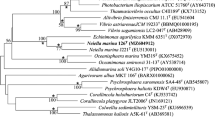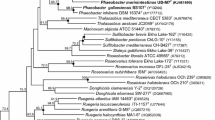Abstract
A novel Gram-negative, non-flagellated, non-gliding, rod-shaped bacterial strain, designated PB-M7T, was isolated from the intestine of a sea cucumber collected from Pohang, South Korea. Growth was observed at 4–30 °C (optimum, 25 °C), pH 6.0–9.0 (optimum, pH 7.0–8.0), and with 2.0–6.0 % (w/v) NaCl (optimum, 2.0 %). In a phylogenetic analysis based on 16S rRNA gene sequences, strain PB-M7T was found to belong to the genus Bizionia and to be most closely related to Bizionia echini KMM 6177T (99.0 % 16S rRNA gene sequence similarity), Bizionia hallyeonensis T-y7T (97.9 %), Bizionia algoritergicola APA-1T (97.5 %), Bizionia argentinensis JUB59T (97.5 %) and Bizionia myxarmorum ADA-4T (97.1 %). The predominant fatty acids of strain PB-M7T were identified as iso-C15:0 (22.2 %), iso-C15:1 G (10.8 %), iso-C17:0 3-OH (16.7 %) and summed feature 3 (C16:1 ω7c and/or C16:1 ω6c; 11.2 %). The major respiratory quinone was identified as menaquinone-6 (MK-6). The polar lipid profile of strain PB-M7T was found to contain phosphatidylethanolamine, an unidentified phospholipid, three unidentified aminolipids and three unidentified lipids. The DNA G + C content of strain PB-M7T was determined to be 33.4 mol% and the mean DNA–DNA relatedness values with the type strains of B. echini, B. hallyeonensis, B. algoritergicola, B. argentinensis, and B. myxarmorum were 52.9, 48.5, 46.5, 37.1 and 26.6 %, respectively. Based on the data presented, strain PB-M7T represents a novel species of the genus Bizionia, for which the name Bizionia psychrotolerans sp. nov. is proposed. The type strain of B. psychrotolerans is PB-M7T (= KCCM 43042 T = JCM 19924 T).

Similar content being viewed by others
References
Bercovich A, Vazquez SC, Yankilevich P, Coria SH, Foti M, Hernandez E, Vidal A, Ruberto L, Melo C, Marenssi S, Criscuolo M, Memoli M, Arguelles M, MacCormack WP (2008) Bizionia argentinensis sp. nov., isolated from surface marine water in Antarctica. Int J Syst Evol Microbiol 58:2363–2367
Bowman JP, Nichols DS (2005) Novel members of the family Flavobacteriaceae from Antarctic maritime habitats including Subsaximicrobium wynnwilliamsii gen. nov., sp. nov., Subsaximicrobium saxinquilinus sp. nov., Subsaxibacter broadyi gen. nov., sp. nov., Lacinutrix copepodicola gen. nov., sp. nov., and novel species of the genera Bizionia, Gelidibacter and Gillisia. Int J Syst Evol Microbiol 55:1471–1486
Bruns A, Rohde M, Berthe-Corti L (2001) Muricauda ruestringensis gen. nov., sp. nov., a facultatively anaerobic, appendaged bacterium from German North Sea intertidal sediment. Int J Syst Evol Microbiol 51:1997–2006
Cowan ST, Steel KJ (1965) Manual for the identification of medical bacteria. Cambridge University Press, London
Ezaki T, Hashimoto Y, Yabuuchi E (1989) Fluorometric deoxyribonucleic acid-deoxyribonucleic acid hybridization in microdilution wells as an alternative to membrane filter hybridization in which radioisotopes are used to determine genetic relatedness among bacterial strains. Int J Syst Bacteriol 39:224–229
Felsenstein J (1981) Evolutionary trees from DNA sequences: a maximum likelihood approach. J Mol Evol 17:368–376
Felsenstein J (1985) Confidence limits on phylogenies: an approach using the bootstrap. Evolution 39:783–791
Felsenstein J (2005) PHYLIP (Phylogeny Inference Package), version 3.6. Distributed by the author Department of Genome Sciences. University of Washington, Seattle
Fitch WM (1971) Toward defining the course of evolution: minimum change for a specific tree topology. Syst Zool 20:406–416
Komagata K, Suzuki K (1987) Lipid and cell-wall analysis in bacterial systematics. Methods Microbiol 19:161–207
Lányí B (1987) Classical and rapid identification methods for medically important bacteria. Methods Microbiol 19:1–67
Minnikin DE, O’Donnell AG, Goodfellow M (1984) An integrated procedure for the extraction of bacterial isoprenoid quinones and polar lipids. J. Microbiol Methods 2:233–241
Minnikin DE, Patel PV, Alshamaony L, Goodfellow M (1977) Polar lipid composition in the classification of Nocardia and related bacteria. Int J Syst Bacteriol 27:104–117
Nedashkovskaya OI, Kim SB, Lysenko AM, Frolova GM, Mikhailov VV, Bae KS (2005) Bizionia paragorgiae gen. nov., sp. nov., a novel member of the family Flavobacteriaceae isolated from the soft coral Paragorgia arborea. Int J Syst Evol Microbiol 55:375–378
Nedashkovskaya OI, Vancanneyt M, Kim SB (2010) Bizionia echini sp. nov., isolated from a sea urchin. Int J Syst Evol Microbiol 60:928–931
Saitou N, Nei M (1987) The neighbor-joining method: a new method for reconstructing phylogenetic trees. Mol Biol Evol 4:406–425
Sasser M (1990) Identification of bacteria by gas chromatography of cellular fatty acids, MIDI Technical Note 101. MIDI Inc, Newark
Tamaoka JK, Komagata K (1984) Determination of DNA base composition by reversed-phase high-performance liquid chromatography. FEMS Microbiol Lett 25:125–128
Thompson JD, Higgins DG, Gibson TJ (1994) CLUSTAL W: improving the sensitivity of progressive multiple sequence alignment through sequence weighting, position-specific gap penalties and weight matrix choice. Nucleic Acids Res 22:4673–4680
Wayne LG, Brenner DJ, Colwell RR, Grimont PAD, Kandler O, Krichevsky MI, Moore LH, Moore WEC, Murray RGE (1987) International Committee on Systematic Bacteriology. Report of the ad hoc committee on reconciliation of approaches to bacterial systematics. Int J Syst Bacteriol 37:463–464
Xin H, Itoh T, Zhou P, Suzuki K, Kamekura M, Nakase T (2000) Natrinema versiforme sp. nov., an extremely halophilic archaeon from Aibi salt lake, Xinjiang, China. Int J Syst Evol Microbiol 50(3):1297–1303
Yoon JH, Lee ST, Park YH (1998) Inter- and intraspecific phylogenetic analysis of the genus Nocardioides and related taxa based on 16S rDNA sequences. Int J Syst Bacteriol 48(Pt 1):187–194
Yoon JH, Kang KH, Park YH (2003) Psychrobacter jeotgali sp. nov., isolated from jeotgal, a traditional Korean fermented seafood. Int J Syst Evol Microbiol 53:449–454
Yoon JH, Kang CH, Jung YT, Kang SJ (2013) Bizionia hallyeonensis sp. nov., isolated from seawater in an oyster farm. Int J Syst Evol Microbiol 63:685–690
Author information
Authors and Affiliations
Corresponding authors
Additional information
Eun-Ji Song and Mi-Hwa Lee have contributed equally to this work.
Rights and permissions
About this article
Cite this article
Song, EJ., Lee, MH., Seo, MJ. et al. Bizionia psychrotolerans sp. nov., a psychrophilic bacterium isolated from the intestine of a sea cucumber (Apostichopus japonicus). Antonie van Leeuwenhoek 106, 837–844 (2014). https://doi.org/10.1007/s10482-014-0253-x
Received:
Accepted:
Published:
Issue Date:
DOI: https://doi.org/10.1007/s10482-014-0253-x




